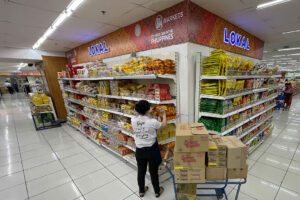PHILIPPINE INFLATION is likely to slow this year to fall within the central bank’s target range, but higher transport charges and domestic rice production pose upside risks, the World Bank said.
In its latest monthly update, the World Bank said that the entry of more rice imports under lower tariffs should help keep inflation within the government’s 2-4% target.
“Inflation resumed its downward trend in August and is on track to fall within target this year,” the Washington-based lender said.
The consumer price index (CPI) eased to 3.3% in August from 4.4% in July. Inflation averaged 3.6% in the first seven months.
The Bangko Sentral ng Pilipinas (BSP) projects inflation to average 3.4% this year.
“The balance of risks to the outlook has shifted toward the downside given expected reductions in rice prices as more imports arrive under the reduced tariff regime,” the World Bank said.
An executive order cutting tariffs on rice to 15% from 35% took effect in July. This helped rice inflation ease to 14.7% in August from 20.9% in July.
However, the World Bank said higher transport and electricity charges, as well as possible global oil and food price shocks still provide upside risks to the inflation outlook.
“Domestic rice production and prices also remain vulnerable with the La Niña weather phenomenon expected to bring more rainfall and intense typhoons in the remaining months of the year,” World Bank said.
Meanwhile, the World Bank said recent external and domestic developments have given the BSP more space for policy easing.
“Peso appreciation, driven by a wider US interest rate differential, supports domestic disinflation. This gives more room for further normalization of domestic monetary policy,” it said.
The BSP began its easing cycle in August by cutting the target reverse repurchase (RRP) rate by 25 bps to 6.25% from the over 17-year high of 6.5%.
BSP Governor Eli M. Remolona, Jr. earlier said the Monetary Board could implement two more rate cuts at its last two meetings on Oct. 16 and Dec. 19.
The latest policy adjustments will also support faster bank lending, the World Bank said.
“Along with lower inflation, the reductions in the real interest rate, and lower reserve requirements could spur demand for credit in the near term by improving business and consumer sentiment,” World Bank said.
“The BSP estimates the full impact of these policy adjustments will be felt with a lag of 12-15 months.”
This month, the BSP will reduce the RRR for big banks and nonbank financial institutions with quasi-banking functions by 250 bps to 7% from 9.5%.
It will also reduce the ratio for digital banks by 200 bps to 4%, thrift banks by 100 bps to 1%, and rural banks and cooperative banks by 100 bps to 0%.
The World Bank noted the beginning of the US Federal Reserve’s easing cycle also helped increase inflows into the Philippines’ financial markets.
“Aggressive rate cuts by the US Federal Reserve have made assets in emerging economies more attractive to international investors and enhanced capital inflows,” the World Bank said.
The US Federal Reserve cut rates by 50 basis points last month, bringing its key policy rate within 4.75-5%.
Meanwhile, the World Bank said manufacturing sector’s performance will likely remain “modest” amid weak external demand for Philippine exports. — BMDC
